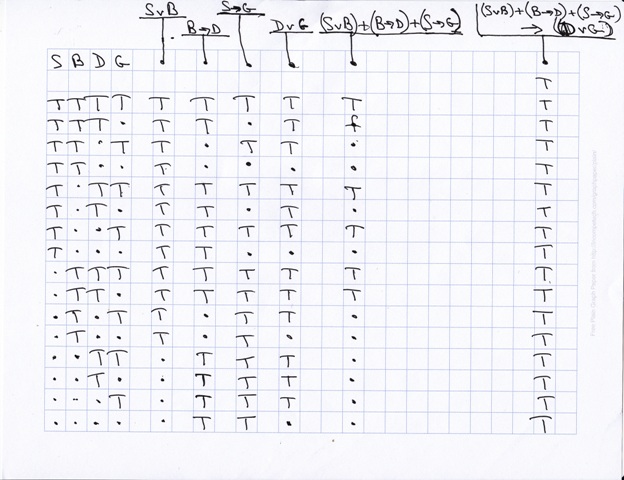Question 542472: Please help with this logic proof:
1. S v B
2. B -> D
3. S -> G
conclusion D v G
Answer by Theo(13342)   (Show Source): (Show Source):
You can put this solution on YOUR website! i never did one like this before.
those instructors just get more inventive every year.
i think you need to use a truth table to determine the validity of this argument.
i read this as:
if (SvB) is true AND if (B->D) is true AND if (S->G) is true, THEN DvG is true.
this is equivalent to the statement:
(SvB) AND (B->D) AND (S->G) -> (DvG)
my truth table concerning this relationship is shown below:

in this table, T is true and . is false.
i used . rather than F because the difference between T and . shows up easier than the difference between T and F.
The first 4 columns are the truth tables for S, B,D,and G by themselves in relationship to each other.
Since there are 4 variable involved, there are 2^4 = 16 number of entries required.
the next column is SvB which translates to S or B.
S or B is true if S is true or if B is true.
it is only false if both S and B are false.
the next column is B->D which translates to B implies D, or: if B then D.
B implies D is true if B is true and D is true, or if B is false.
it is only false if B is true and D is false.
the next column is S->G which translates to S implies G, or: if S then G.
S implies G is true if S is true and G is true, or if S is false.
it is only false if S is true and G is false.
the next column is DvG which translates to D or G.
D or G is true if D is true or if G is true.
it is only false if both D and G are false.
the next column is (SvB)+(B->D)+S->G) which translates to SvB AND B->D AND S->G
it is only true if SvB and B->D and S->G are all true.
if any of them is false, then this category is also false.
the last column is ((SvB)+(B->D)+(S->G))->(DvG).
this says that is SvB is true and B->D is true and S->G is true, then DvG is true.
this last column is false only if SvB is true and B->D is true and S->G is true and DvG is false.
otherwise it is true.
since this last column is true in all circumstances, then it is reasonable to conclude that the fact that SvB and B->D and S->G are true implies that DvG is true.
There are no conditions where all 3 of them are true and DvG is not true.
i believe this is what you are looking for.
under the assumptions that i made about what the problem is addressing, the logic in the truth table proves that the original statements are true based on that interpretation.
good luck with this one.
hopefully this interpretation is correct.
|
|
|